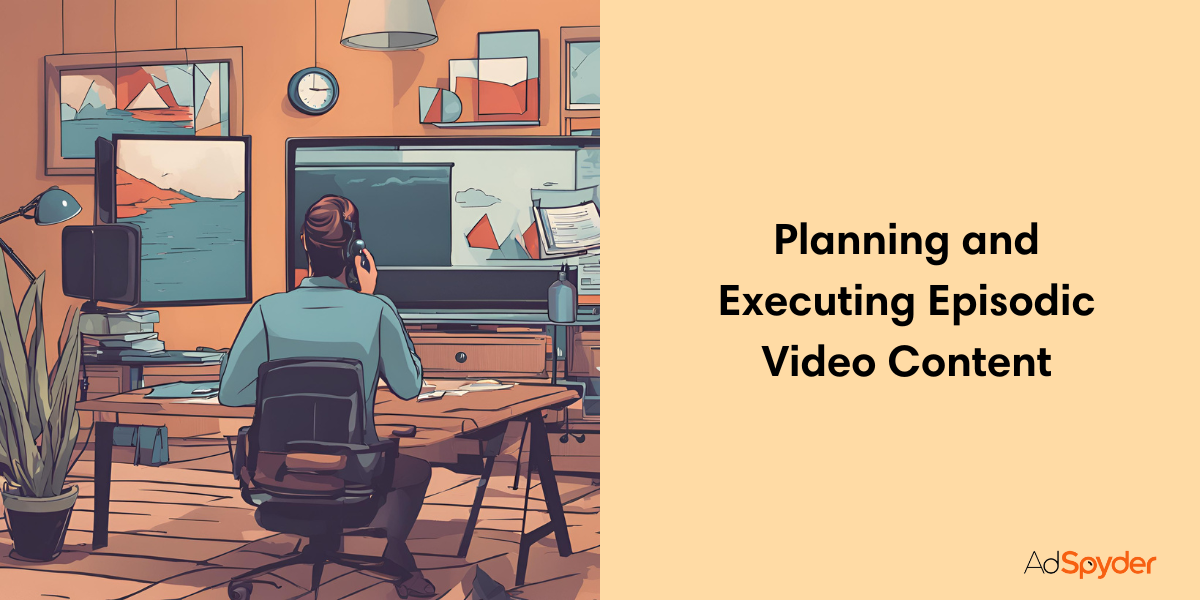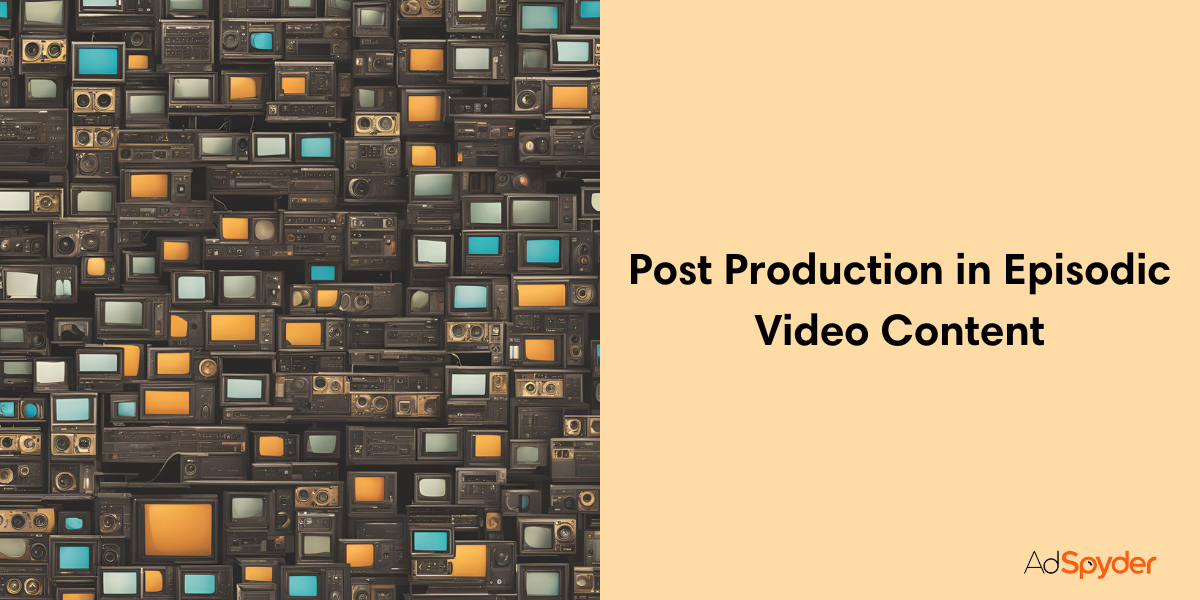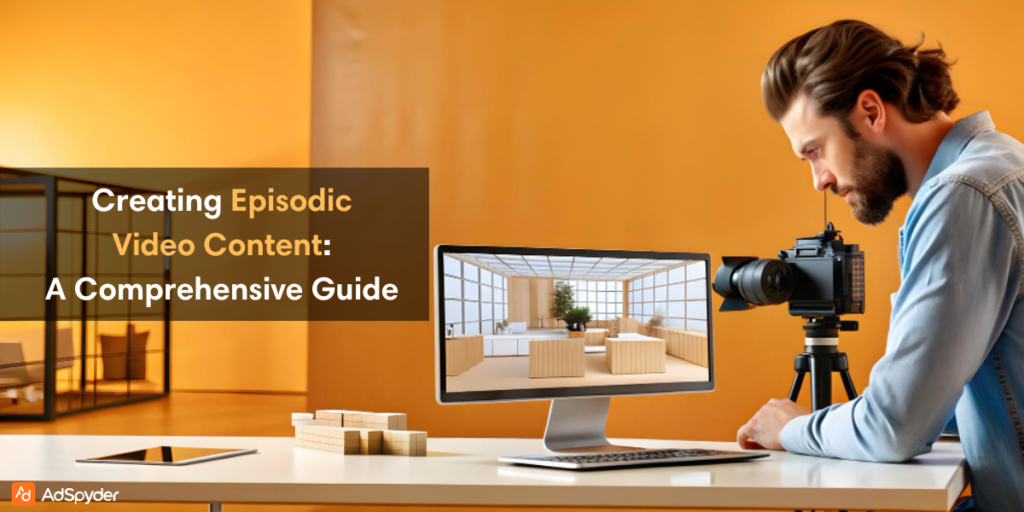Making good video content is tough. Now, people love videos that tell a story over many episodes. This guide shows you creating episodic video content. Your stories will reach and touch lots of viewers. To begin with, you should understand that your videos are supposed to tell a story that needs to be good. For this, you must consider what your audience wants. Accordingly, you should share these stories in parts. The step is to ensure that your audience is engaged to move to another chapter and always looking out for more.
Ready to Elevate your Marketing Strategy?
Summary
This blog covers:
- The significance of Episodic video content.
- How to develop a compelling video series.
- Strategies to create high-quality episodic video content.
- A detailed FAQ section to address common questions.
Creating Episodic Video Content to Keep Your Audience Engaged

Understanding Of Creating Episodic Video Content
Episodic video content creates a series of story-driven videos. This method hooks viewers and keeps them excited for the next episode.
Definition and Importance
Series syndicated into episodes depict a great story in installments. You get this in things like Friends, Harry Potter and so on You can get to watch several episodes, thanks to Netflix, Hulu, and Amazon Prime. This has made storytelling more interesting to many.
Due to watching shows episode by episode, fans continue to return. It is good for the duration of viewers. Moreover, with the help of streaming platforms, these stories touch people across the world.
A survey has revealed that as high as 83% of marketers believe that use of video increases their returns on investment (ROI). This means that in the near future, videos will account for eighty two percent of internet usage. The serial format appeals to audiences waiting for the next episode to come up. They are engaged and remain faithful to the show or advertising that they await the next chapter.
Identifying Your Objectives and Audience
Figure out your goals and know your audience before making your videos. Learn more to get better.
Setting Clear Goals
Goals define the directions in which your video series is moving. Concentrate on creating high quality content, posting frequently and advertising with social networking sites. Make sure to team up and come up with new ideas in your videos. Streaming services seek programs that viewers would come back for. Stick to a schedule, produce better episodes, tell everyone, find people who are on the same wavelength, and try something new. Choose wise strategies for acquiring and retaining streaming service subscribers. Consider what makes your show unique and how you can maintain the pace of putting out episodes without compromising on quality.
Learn how to get the word out about your show via social media and other technological platforms. Think about working with other creators or interacting with communities that appreciate your kind of posts.
Understanding Your Target Audience
First, identify your target demographic.
- Find out what kind of videos they prefer and on which platforms they consume video content.
- A significant number of millennials engage in watching video on social media on a daily basis. Plenty of people go to the website after watching a related YouTube video.
- It also means that the content of the video that you produce should be in line with the interests of your audience.
- Since buyers use 3-5 pieces of content before making the purchase, it is crucial to create episodic engaging content.
Thus, this approach can reduce sales cycle time and increase the recall of your brand where prospects spend their time.
Concept Development
To make your episodic video content grab attention, focus on crafting solid concepts. This approach brings your ideas to life and boosts audience engagement across digital platforms.
Brainstorming Ideas
Making great episodic content begins with big ideas. Storytelling grabs viewers and keeps them coming back.
- Look at what your audience likes and needs to pick topics that will grab their attention.
- Check out successful stories from B2B brands that focus on the customer for ideas.
- Have a team meeting where everyone can share their craziest ideas in a creative space.
- Use mind maps to sort thoughts visually and see how different concepts connect.
- Keep up with trends in your industry to find ways to tie them into your video content.
- Think about problems or questions your audience has and show how your episodes can solve or answer them.
- Finally, go through forums, social media, and customer feedback for direct insights into what people want to watch next.
Creating a Compelling Narrative
To hook your audience, start with strong ideas that match their interests.
- Look at what’s already out there or invent something new for inspiration.
- Make sure episodes flow into one another. This keeps people looking forward to the next part of the story.
- You have the freedom to dive deep into various parts of your tale here.
It’s key to link your content closely with who you’re aiming it at. This makes sure your audience stays hooked on what you’re telling them through the whole series.
Content Planning
Start by planning great content to make your episodes stand out. Learn how to turn ideas into videos that capture your audience’s interest.
Episode Structure
Good episode structure keeps viewers coming back and makes your series flow well. It creates an engaging narrative progression that hooks audiences.
- Begin every episode with something exciting to catch attention.
- Introduce problems or conflicts early to keep people watching and move the storyline along.
- Keep episodes about the same length for consistency and rhythm.
- Reveal characters a bit at a time through multiple episodes, making fans eager to see what’s next.
Ending an episode on a cliffhanger gets viewers excited for more. Using callbacks and foretelling maintains story continuity and adds depth. A twist in the middle of the season keeps things interesting and avoids feeling too predictable.
Scriptwriting
Scriptwriting turns your ideas into a script. This shapes the video’s message and makes it look more professional. But, too much scripting can make speaking seem stiff. It’s important to mix well-planned structure with freedom for creativity. In this process, you plot out what each episode will cover. This helps later when you want to break down content for smaller bits, like how GaryVee does it. You pick main points or highlights for every part of your video series.
Also, choose the best call to action (CTA) that fits all episodes to guide viewers on what to do next. By doing this, you keep videos engaging and clear on messaging while guiding your audience clearly on their next step after watching.
Planning and Executing of Creating Episodic Video Content

Creating episodic video content helps tell stories that capture and keep viewers’ interest, making them eager to see what happens next.
Pre-Production Planning
Pre-production planning makes episodic video content interesting. This step makes sure videos fit with the brand’s message and goals.
- Make a plan for your video series to guide production.
- Find stories in your brand by linking customer problems to how people use your products or services. For videos on healthcare, the concept can be on a day in the lives of healthcare providers or interaction with patients.
- Make sure the content reflects the company’s messages and aims through smart planning.
- Figure out who will watch your videos so you can make content they care about.
- Set clear production deadlines so everyone knows when work is due.
- Work out a budget early to use money wisely and keep spending in check.
- Pick topics that are both fun and teach something, showing off what makes your products or services special while helping viewers.
- Write an episode outline to help with scriptwriting, filming, and editing.
- Watch pre-production steps closely to tweak plans for the best outcome.
Scheduling and Budgeting
Scheduling and budgeting are crucial for episodic video content. They help you manage time and money to keep things on track.
- You set a timetable for every step, from the start to the end. This makes sure all tasks get done on time.
- For budgets, you decide how much money goes where. This includes paying actors, crew, buying equipment, and covering location costs. It’s about using what you have wisely without spending too much.
- Making a schedule means knowing what needs to happen and breaking it down into smaller parts. The goal is no delays or extra costs that could mess up your project.
- With financial planning, you look at your money and figure out how to make the biggest impact.
Both of these steps keep everyone aimed at their goals while keeping problems like delays or going over budget away.
Casting and Crew
Making great episodic video content starts with a strong team. You need the right people to make your ideas come to life.
- Start planning who you need for your show early on. Think about the characters and find actors who can play these parts well.
- Hold auditions to pick the best actors for your roles. This makes sure they fit their characters perfectly.
- Choose a director who gets what you’re trying to do. They will help keep everything on track with your vision.
- Get skilled production staff. You’ll need experts in lighting, sound, and cameras.
- CineSalon offers all-around services including casting and crew selection—worth checking out.
- If you don’t have a place to film, look into renting a studio space.
- Begin with basic filming equipment and get better gear as you have more money.
- Good audio is key, so invest in quality mics like those from Audio-Technica AT2020 or Zoom H1 for clean sound.
- Find a crew that knows various filming techniques to keep your episodes fresh and interesting.
- Make sure your editing team can piece together your story well after filming wraps up.
By following these tips, you’ll be able to make engaging video series that draw in viewers episode after episode.
Production
The team shoots the video as planned and follows the director. They make the script come alive through careful work.
Filming Techniques
Filming techniques in creating episodic video content mix the same quality and new ideas to keep people watching.
- Using different styles of cinematography makes each episode fresh but keeps a series looking like it fits together. Directors use visual storytelling and how they build the story to connect with viewers.
- Creative direction is important for making each part of the script strong and memorable. Innovative filming methods are key to keeping people interested in episodic content.
- Choosing a good directorial style and editing can make a series more valuable.
- By developing the story well and paying attention to how things look, filmmakers create a world that feels real to their characters and sticks with viewers.
- Sound choices in how to direct and edit add value to the show.
Filmmakers work hard on story development and making sure everything looks great, creating an experience that pulls audiences into their characters’ lives.
Directing
Directing mixes art with planning. A director leads actors, picks camera angles, and decides on lighting.
- This makes sure each scene matches the story’s mood and style. Good lighting is key.
- It sets the mood and improves video quality, making scenes feel different.
- Then comes editing. Here, all recorded footage is shaped into a final product.
Post Production

After shooting your video, post-production begins. This part mixes editing and sound to complete your film.
Editing
Editing turns raw footage into a compelling story. It combines visuals, audio, and effects to keep the story engaging from start to finish. Editors cut scenes, add music for emotion, and adjust sounds for clear listening.
B2B brands improve their complex products with editing. They create episodic content that keeps viewers coming back. This method helps connect with the audience and grows brand interest over time.
Sound Design and Music
Sound design and music grab your attention in videos. They make you feel strong emotions and stay interested. These tools help stories seem real and moving. Smart use of sound can make simple scenes memorable.
Next, decide where to share your videos and how to let people know about them.
Distribution and Promotion
Pick smart places to share your episodic video content. Use clever tricks to grab and keep people’s attention.
Platform Selection
Choosing the right video streaming platform is key for creating video episodic content.
- Platforms like Netflix, Hulu, and Amazon Prime make binge-watching easy. This keeps viewers coming back. A good choice boosts viewer engagement and loyalty.
- It also can be used in Facebook stories, where you can use Facebook Geolift campaigns to promote your episodic videos to see how your audience respond location wise.
- Use data analytics to see what your audience enjoys. This helps create content they’ll love.
- For promotion, use social media, email newsletters, and online tools to share your show. Different platforms reach different people. Match your promotional work with where your target audience hangs out online.
Promotional Strategies
If you want the audience to start discussing your video series with each other, then turn to social media ads and other digital techniques.
- Nike and Gucci, for instance, upload episodes on a weekly basis and people take notice of them. That is why many streaming platforms rely on fresh shows to hook people in. They also attract social proof, which can be further used for your marketing strategies.
- Keeping audiences’ attention is equally important. Some episodes may be made available for free or for a fee with the hope of getting viewers to subscribe.
- This strategy assists you in standing out in a saturated market and consequently attracting more followers for the show.
The Journey of Sarah’s Startup
Background: Sarah, a young entrepreneur, launched a small business offering eco-friendly products. She struggled to reach a wider audience and engage customers.
Objective: Increase brand awareness and customer engagement through episodic video content.
Implementation:
- Developing the Concept: Sarah created a video series titled “The Journey of Sarah’s Startup,” documenting her entrepreneurial journey, challenges, and successes.
- Structure: Each episode focused on different aspects of her business, from product development to marketing strategies.
- Promotion: Sarah used social media platforms like Instagram and YouTube to release weekly episodes, encouraging viewers to follow her journey and share their own experiences.
Outcome: The episodic content resonated with viewers, leading to a significant increase in website traffic and social media followers. Sarah’s authenticity and transparency fostered a loyal community of supporters who eagerly awaited each new episode.
Tech Tips with Tim
Background: Tim, a tech enthusiast and blogger, wanted to expand his audience and provide valuable content to his followers.
Objective: Educate and engage his audience with practical tech advice through episodic video content.
Implementation:
- Developing the Concept: Tim launched a series called “Tech Tips with Tim,” where he shared easy-to-follow tutorials and reviews of the latest gadgets and software.
- Structure: Each episode was concise, focusing on a specific tech topic or product. Tim included interactive elements, such as Q&A sessions and viewer polls, to enhance engagement.
- Promotion: Tim leveraged his existing blog and email newsletter to promote the series. He also collaborated with tech brands for sponsored episodes, expanding his reach.
Outcome: Tim’s episodic content helped him build a strong following on YouTube and other social media platforms. His engaging and informative videos attracted partnerships with tech companies, boosting his credibility and income.
Cooking with Clara
Background: Clara, a home chef, aimed to share her passion for cooking and connect with fellow food enthusiasts.
Objective: Build a community of food lovers and inspire them with episodic cooking videos.
Implementation:
- Developing the Concept: Clara started a series called “Cooking with Clara,” where she showcased her favorite recipes and cooking tips. Each episode featured a complete dish, from ingredient preparation to plating.
- Structure: The episodes were visually appealing and easy to follow. Clara included personal stories and cultural insights related to the dishes, adding a unique touch to her videos.
- Promotion: Clara utilized social media, particularly Instagram and Facebook, to release episodes and engage with her audience. She encouraged viewers to try the recipes and share their results using a specific hashtag.
Outcome: Clara’s episodic content gained popularity, attracting a diverse audience of food enthusiasts. Her authentic storytelling and delicious recipes led to collaborations with food brands and an invitation to host cooking workshops, further expanding her influence.
FAQs
Episodic video content is a series of videos that follow a continuous theme. The significance is that it helps build a loyal and engaged audience, encouraging them to return to the next episode.
Make sure to be consistent in your content. Use engaging character, and relatable series. End the episode on a cliffhanger.
Organize each episode into the basic story form of a beginning, middle, and ending. It is always recommended to choose the format and length according to the nature and shared by the target audience interests.
In the pre-production planning process, other important activities that need to be planned well include the formulation of the production calendar, estimating and allocating resources for all the activities needed to bring the vision into reality, and identifying and hiring of talent and crew.
By using professional tools and equipment, adequate lighting, good sound and filming strategies, quality production can be achieved. Coordinate talent and crew to ensure that your vision is consistent and that you are able to produce what you want.
Maintain a consistent pace, using smooth transitions, and incorporating visual effects to enhance the viewing experience. Pay attention to detail, ensure continuity, and create a polished final product that aligns with your vision.
Conclusion
Recap
Episodic content splits stories into episodes, each part of a big plot. Keeping things consistent and high-quality helps it grow. Social media also plays a big role. With more digital platforms popping up, episodic content is becoming more common. Streaming services are big fans of creating original shows to keep viewers coming back. This way of telling stories is changing entertainment and the way fans connect with creators. Fans get really involved, making art and writing their own stories about their favorite episodes online. They share these on online fan communities, boosting fan engagement. Streaming platforms are always on the lookout for fresh storytelling innovation and diverse narratives to capture wide audiences.
Final Thoughts
Creating episodic video content is a strong way to tell stories and connect with people. This guide helps you start from understanding episodic content to planning, making, and sharing your series. With a good strategy and creativity, your videos can win hearts and keep viewers coming back. Making great episodes needs work but pays off in more engagement and loyalty. Share your story one episode at a time!
Call to Action
We encourage you to start creating episodic video content. Share your experiences and insights in the comments below, and let’s build a community of creators dedicated to producing engaging and impactful video series.




